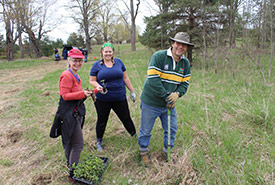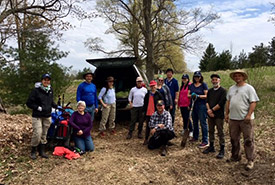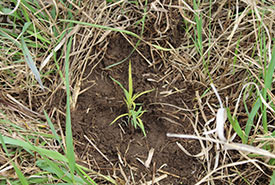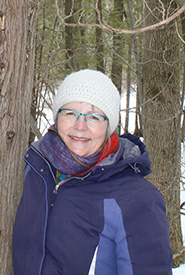Meadows for Monarchs

Meadows for Monarchs event participants (Photo by NCC)
If you thought you saw more monarchs flitting about last summer and fall, you were right. Monarch Watch reported that 2018 was a good year for the iconic orange and black butterfly, thanks to a combination of aggressive conservation efforts in Mexico (where they overwinter), habitat restoration throughout Mexico, the U.S. and Canada, as well as good weather conditions. While this is encouraging, there’s still much to be done to support this endangered species.
On May 16, 2019, I participated in the Meadows for Monarchs Conservation Volunteers event, which was hosted by the Nature Conservancy of Canada (NCC) and generously supported by Earth Rangers. It took place at the Goulding West property in Mono, Ontario, a town east of Orangeville. The 32-hectare (79-acre) former farm lies within the Niagara Escarpment, Oak Ridges Moraine and Humber Headwaters. The area is made up of mixed forest, streams, wetlands and meadows. It was an ideal day for working outside; not too hot, not too wet and not too many bugs. The terrain was hilly and a bit challenging for planting at times, but it provided us with lovely views of the surrounding countryside.
Related blog posts
The habitat restoration goal was to plant native grass and flower species over approximately 6 hectares (15 acres) of former hay fields. Milkweed, the critical host plant for monarch caterpillars, was plentiful, but a greater number and diversity of nectar sources help adult monarchs get through the summer and prepare for their fall migration. Not to mention, increasing the native plant diversity of the meadow also benefits other pollinators and wildlife.

NCC staff and Conservation Volunteers (Photo by NCC)
The crew of 16 volunteers was led by NCC’s coordinator of conservation biology, Jenna Siu, who studied two butterfly species in southern Ontario for her master’s research.
Restoration ecologist Dan Barcza from the Sage Earth Environmental and Restoration Services was contracted to plan the restoration project and select a variety of native plant species, which were organized into three categories corresponding to the conditions that they would grow best in.
Following Dan’s instructions, volunteers grouped themselves into teams of three or four to form a planting assembly line. After scuffing the ground with their feet to expose the earth, the first member of each team used a stand-up weeding tool to remove a plug of soil. Other team members filled the resulting hole with a plug that contained a seedling.

A planted seedling (Photo by NCC)
Over the course of nearly five hours, the area was filled with alternating rows of New England aster, Virginia wild rye, big bluestem, yarrow, wild bergamot, black-eyed Susan, hoary vervain, swamp milkweed and many other species. At the end of the day, an estimated 2,000 plugs were planted, with an expected 25 to 50 per cent survival rate. What is important is that a few of these plugs successfully flower and spread their seeds to increase the native plant diversity.
During our lunch break, we enjoyed talking to fellow nature lovers and learning their reasons for volunteering their time and effort. Many of us commented how we would like to return to the site in the future to see the fruits of our labour. The thought of having helped create a pollinator haven gave us all a great deal of satisfaction. I can’t wait for the next volunteer event!


